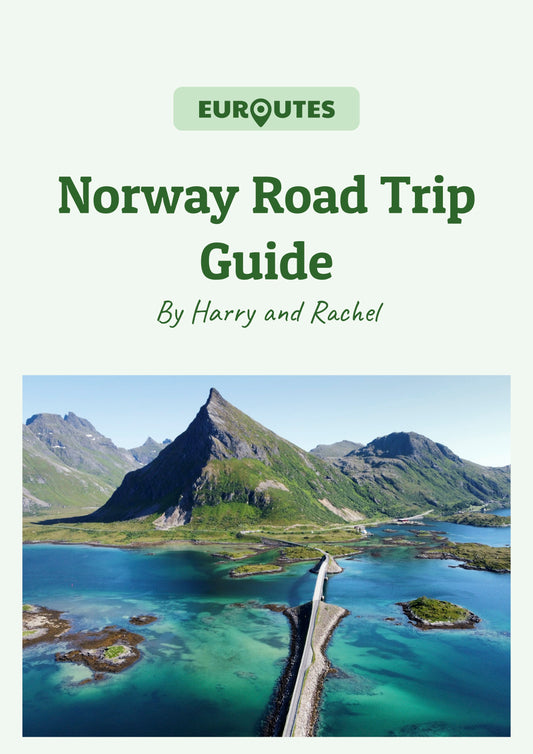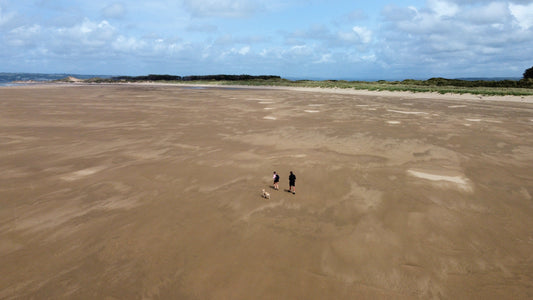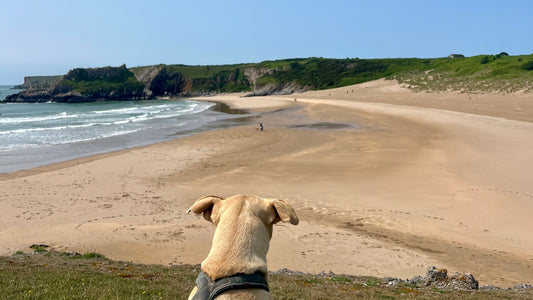
Ultimate Guide to a Europe Road Trip Adventure With Your Dog in 2025
We've all been there, planning a holiday but feeling sad at the thought of leaving your dog behind. After traveling to over 20 countries in Europe (and a little beyond) with our dog, we've compiled the ultimate guide to taking your furry friend with you. Trust us, you'll all be happier for it!
Table of Contents
- What to consider to road trip Europe with your dog
- Border requirements to enter the EU
- How long are you going for?
- Where are you going?
- Are you planning to leave the EU?
- Dog-friendly Transport to Europe
- What about heading back to the UK?
- Catering for your dogs needs
- Best places to travel in Europe with a dog
- Norway
- Dreaming of a Norwegian road trip with your dog?
- Spain
- Portugal
- The Alps (France, Switzerland, Germany, Austria, Italy and Slovenia)
- The Balkans
- Guide to road tripping Europe with your dog
What to consider to road trip Europe with your dog
Border requirements to enter the EU
- Rabies Vaccination: The first thing to consider is their age, to enter the EU, your dog needs to be at least 12 weeks old, this is because they need to have had their first rabies jab and have a microchip.
- European Pet Passport or Animal Health Certificate: You also need to get their documents to travel. If you’re from the UK, you will need to get an animal health certificate no more than 10 days before you travel. You can get this from the vets and they last for 4 months, or earlier if your pet's rabies vaccination expires before the 4 months is up. If you plan to travel longer than this it is possible to get your dog an EU passport at a vets in the EU. If your pet already has an EU passport then you don't need to worry about the animal health certificate
🇪🇺 There is also good news for UK travellers with their dog as it has been announced that pet passports will make a return, making it easier and less expensive to travel with your dog. There are no dates announced yet.

How long are you going for?
If it’s just a short trip then you don’t need to worry about any of their medication or treatment, unless they have regular medication. If you’re going for longer you might want to think about what flea and tick treatment to use and also how you will regularly treat them for worms. We usually opt for a flea collar and get a worming tablet whenever we got to the vets.
Where are you going?
Most countries in the EU are satisfied with these requirements; a microchip, valid rabies vaccination and passport or animal health certificate. But there are countries in Europe that require more.
For countries that are free of tapeworm; (Finland, Ireland, Malta, Norway and Northern Ireland) you need to get tapeworm Echinococcus multilocularis treatment administered 24 hours to 5 days before you travel.
Are you planning to leave the EU?
Some countries outside of the EU, and especially outside of Europe, require a few extra steps to be able to take your dog into them. You might need a rabies antibody titre test which proves your pet has the rabies antibodies.
Considering taking your dog to Morocco? Read our blog below.
👉 Travelling Morocco with a dog
Dog-friendly Transport to Europe
We find the Eurotunnel (Le Shuttle) to be the best method for traveling with a pet. It's really easy as they stay in the vehicle with you:
- Pet Check-In: You check your pet in and scan their microchip.
- Pet Exercise Area: There’s a pet exercise area so you can let your dog go to the toilet and walk before you get back in your vehicle.
- Travel Time: Your pet stays in the vehicle with you, and the travel time is less than an hour, making it a stress-free experience.
You can also get ferries and they are only a short duration so it’s not too bad but you do normally have to leave your pet in the vehicle alone so you will need to ensure they are used to doing that beforehand.
If you're planning to travel in a campervan, read our blog below
👉🏻 Important considerations for van life with a dog.
What about heading back to the UK?
It’s a requirement to get your dog treated for tapeworm, 24 hours to 5 days before going back to the UK. This has been a rule for a long time so vets in most countries in Western Europe are familiar with doing this.
Tip: Tapeworm treatment is generally more expensive in France and the Netherlands than Spain and Portugal, so if you have the choice and are on a budget, try to get this done in a cheaper country!

Catering for your dogs needs
What time of year are you going?
Is the time of year that you’re travelling suitable for your dog and do you have what you need to manage your dog in the weather and temperatures. Summer in Europe can get very hot. We think Scandinavia is a perfect place to road trip in summer with your pet because it never gets too hot, but more on that in the next section.
You can pack things to manage the heat, for example cooling mats are very popular. Or, basing yourself around places where you have access to shade and water so that your dog can keep themself cool. 💦
Does your dog have any unique needs?
If your dog is picky with food then you might want to make sure that you have enough food for your trip. While most countries in Western Europe have a lot of choice of dog food, they may not have the particular brand you’re after, so if your dog is used to eating particular food then make sure you have stocked up enough to keep them happy.
Useful accessories to pack
- Tag for their collar with your contact information, your phone number will be one of the most important details when abroad.
- Consider getting your pet a GPS tracker that provides live data so that you always know where they are.
- Drag line or long leash, this is a must in our opinion, it allows them to roam around you but always be under your control. We use a 10 metre one but you can get them up to 20 metres.
- Chest harness, if you’re using a long leash then this will give you more control and make sure your dog is safer than with a collar. We get our bits like this from Non-stop dogwear, they’re tough and good quality.
- Life jacket, if you plan on taking your dog along on any water activities, this is essential.
- A seatbelt, we attach ours to Sandy’s harness so that we know she is secure when we are driving.
- Collapsible drinking bowl, this is a must on our hikes.
- A towel or bathrobe that your dog can wear, this is great for when you have a wet dog that wants to get in your van.
Best places to travel in Europe with a dog
From our experience, these are the most dog-friendly places we've been in Europe:
Norway
✅ Pros: Norway is one of the best place to travel in Europe with a dog because of the abundant nature to explore and the relatively low population density. There are mountains, beaches, fjords etc and you can find places to explore with hardly anyone around. Norway has cooler summer temperatures so it’s the perfect place to explore in the summer holidays.
❌ Cons: Restaurants and shopping centres are not that dog-friendly. Your dog has to be on a lead at all times due to wildlife.

Dreaming of a Norwegian road trip with your dog?
Experience the incredible natural landscapes of Norway with our Norway Road Trip Guide, we've planned a road trip route up to 3 months across Western and Northern Norway with hundreds of dog friendly activities along the way all detailed in an accompanying map. All you need to do is drive!
Price: £14.99
Shop nowSpain
✅ Pros: Highly dog-friendly with plenty of outdoor seating at restaurants. On all of our travels, we saw the most locals with pets here.
There were clear signs where dogs can and can’t go on the beach. We visited out of season and think it could be difficult in peak season as there are a lot of ‘no dog’ signs on beaches.
❌ Cons: Personally, we would not choose to explore somewhere like Spain in summer due to the heat. We struggle enough ourselves, let alone having our dog in the campervan.
Portugal
✅ Pros: Portugal has so many large beaches to walk on, offering plenty of space for your dog to run and play. Since our dog absolutely loves the beach, it doesn't get much more dog-friendly than this.
Cons: Similarly to Spain, we probably would not choose to explore here in summer due to the heat.
The Alps (France, Switzerland, Germany, Austria, Italy and Slovenia)
✅ Pros: The Alps are ideal for hiking and generally dog-friendly, with dogs usually allowed in gondolas.
❌ Cons: Some lakes do not allow dogs, and there may be specific dog beaches. It can get really hot in the summer so finding somewhere you can cool your dog down in a lake is ideal. The Alpine regions can get pretty busy in the summer months, so if you're dog is not great around people or other dogs then it might not be the best time to travel there.

The Balkans
General Note
Eastern Europe, including the Balkans, is generally not the best place to travel in Europe with a dog because it has a significant number of stray dogs. However, most of the dogs are harmless so you shouldn’t worry about too much, simply be prepared for the reality. It’s still possible to travel here no problem with your dog, you should just be aware of the situation.
People are generally a bit more afraid of dogs in these countries, however there are also people who love dogs and they are even more obsessed with dogs having seen all the strays around them. It can be really hot here in the summer so that is something to consider. There are some differences between the countries here so we’ll outline our experience
Croatia: Fewer strays than elsewhere in the Balkan’s, possibly because it’s been more touristy for a while than other surrounding countries. A lot of the beaches are stones/pebbles so it’s not necessarily the best place to walk a dog. It can also be super busy in the summer, but isn’t everywhere!
Albania: We rescued our dog in Albania and travelled there with her as a puppy. The strays are in some of the worst conditions we’ve seen, but people are generally welcoming to pets.

Montenegro: A lot of stray dogs in the mountain areas but again they are pretty friendly. There are loads of beautiful places and nature to explore and take your dog.
Bulgaria: Fewer strays than other surrounding countries as more is being done there to help them. There are lots of nice mountains in Bulgaria such as the Pirin mountains and Rila National Park as well as lots of lovely sandy beaches to walk the dog on.
Romania: We travelled Romania in August and at times it was far too hot for our dog we had to just camp out near water to stay cool. It can be pretty busy but people either move out of the way of your dog if they’re scared or they want to say hello. Lots of lovely nature to explore, we found the coast not as good as Bulgaria as there were a lot of resorts.
Greece: Out of season Greece is an amazing place to be with your dog because there are loads of stunning beaches, people generally take very good care of the stray dogs here and absolutely love them.
Guide to road tripping Europe with your dog
We hope this convinces you and helps you plan a road trip in Europe with your dog. From our experience, these are our best tips for taking your dog from the UK and the best places you can visit with them!







